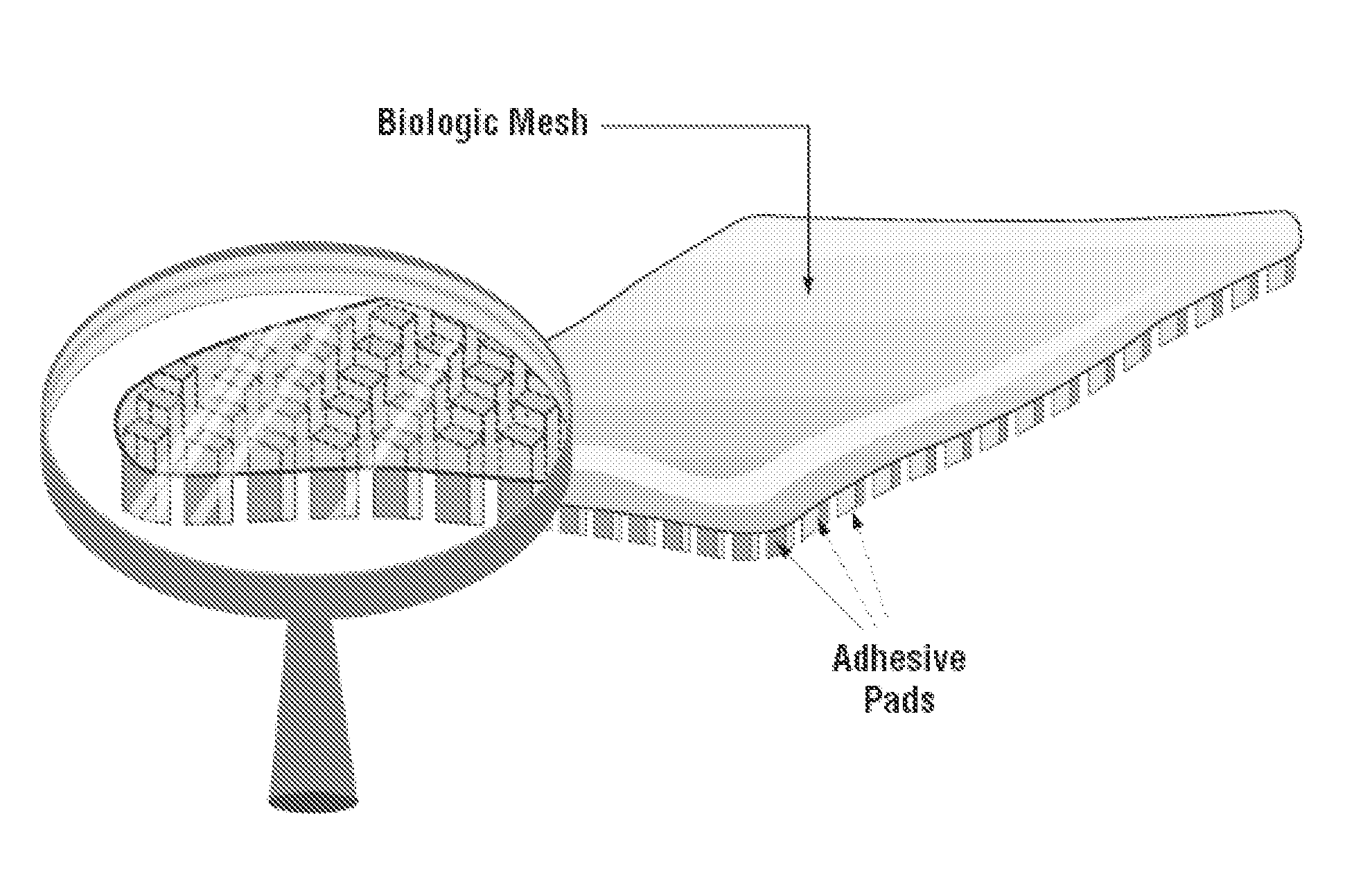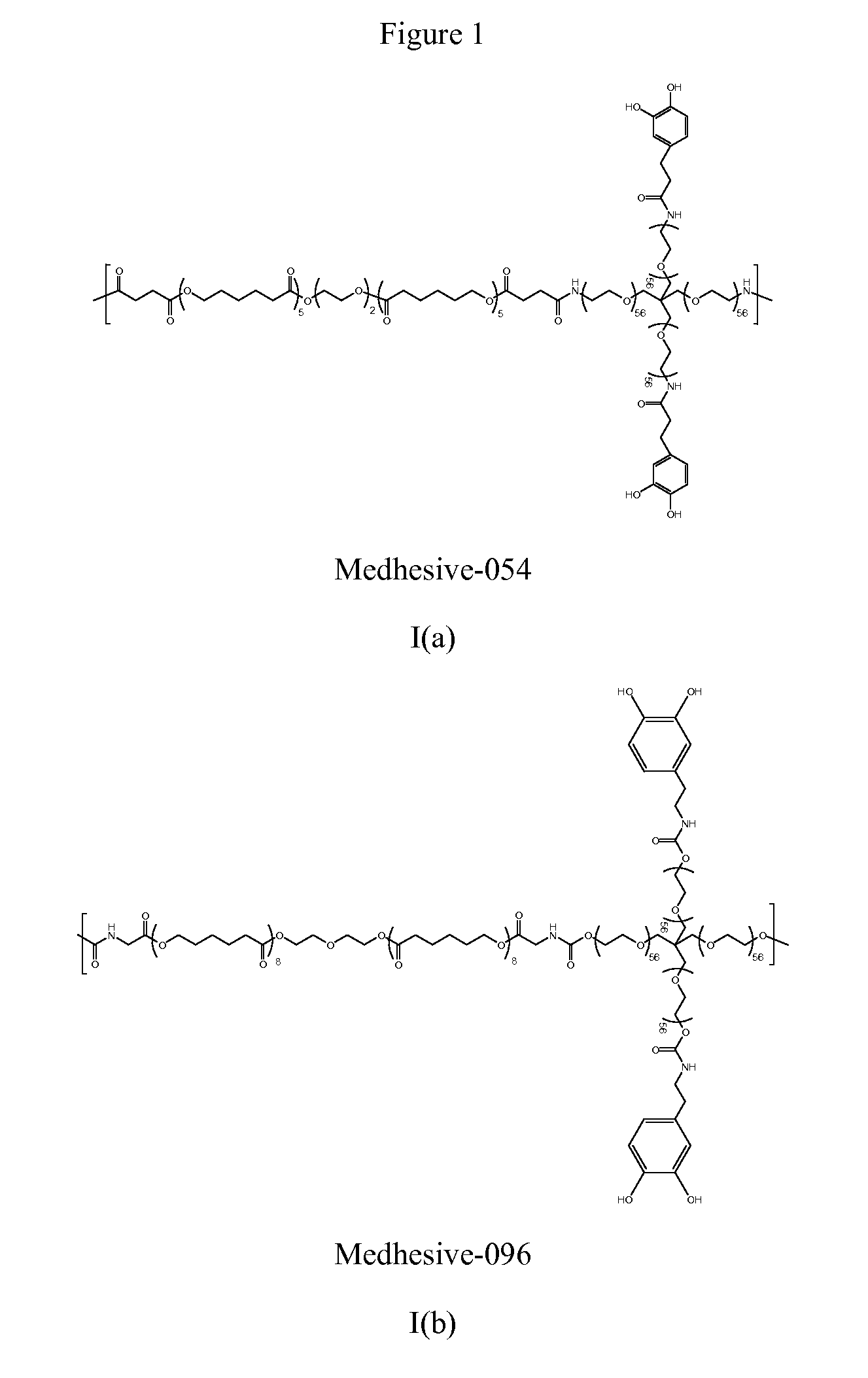Multibranched bioadhesive compounds and synthetic methods therefor
a bioadhesive compound and multi-branched technology, applied in the field of new synthetic medical adhesives, can solve the problems of inability to completely solve the problem of chronic infections, poor tissue adhesion characteristics, and no one approach has yet proved completely effective, and achieve the effect of inhibiting or reducing the growth of biofilm (bacteria)
- Summary
- Abstract
- Description
- Claims
- Application Information
AI Technical Summary
Benefits of technology
Problems solved by technology
Method used
Image
Examples
example 1
Synthesis of Surphys-029
[0283]Dissolved 10 g of 4-arm PEG-NH2 (10,000 MW; 1 mmol), 600 mg of poly(ethyleneglycol) bis(carboxymethyl)ether (PEG-bCME, Mn ˜600, 1 mmol), and 456 mg of 3,4-dihydroxyhydrocinnamic acid (DOHA, 2.5 mmol) with 40 ml chloroform and 20 ml DMF in a round bottom flask equipped with an addition funnel. Added 676 mg of HOBt (5 mmol), 1.9 g of HBTU (5 mmol), and 560 μL of triethylamine (4 mmol) in 30 mL of DMF dropwise to the round bottom flask over a period of 90 minutes. Stirred at room temperature for 2 hours. Added the mixture to 600 mL of diethyl ether. The precipitate was collected via vacuum filtration and dried. The crude product was further purified through dialysis (15,000 MWCO) in deionized H2O (acidified to pH 3.5) for 24 hrs. After lyophilization, 6.3 g of Surphys-029 was obtained. 1H NMR (400 MHz, D2O): δ 6.85-6.67 (m, 3H, C6H3(OH)2—), 4.09 (s, 2H, PEG-CH2—O—C(O)—NH—), 3.75-3.28 (m, PEG), 2.8 (t, 2H, C6H3(OH)2—CH2—CH2—C(O)—NH—), 2.51 (t, 2H, C6H3(OH)2...
example 2
Synthesis of PCL1.25k-diSA
[0284]Added 10 g of polycaprolactone-diol (PCL-diol, MW=1,250, 8 mmol), 8 g of succinic anhydride (SA, 80 mmol), 6.4 mL of pyridine (80 mmol), and 100 mL of chloroform to a round bottom flask (250 mL). Refluxed the solution in a 75-85° C. oil bath with Ar purging for overnight. Allowed the reaction mixture to cool to room temperature and 100 mL of chloroform was added. Washed the mixture successively with 100 mL each of 12.1 mM HCl, saturated NaCl, and deionized water. The organic layer was dried over magnesium sulfate and then the volume of the mixture was reduced by half by rotary evaporator. After pouring the mixture into 800 mL of a 1:1 hexane and diethyl ether, the polymer was allowed to precipitate at 4° C. for overnight. The polymer was collected and dried under vacuum to yield 8.1 g of PCL1.25 k-diSA. 1H NMR (400 MHz, DMSO / TMS): δ 12.2 (s, 1H, COOH—), 4.1 (s, 2H, PCL-CO—CH2—CH2—COOH—) 4.0 (s, 12H, O—(CO—CH2—(CH2)4—O)6CO—CH2—CH2—COOH), 3.6 (s, 2H, PC...
example 3
Synthesis of PCL2k-diGly
[0285]Dissolved 10 g of polycaprolactone-diol (5 mmole, MW 2000) with 2.63 g of Boc-Gly-OH (15 mmole) in 60 mL chloroform and purged with argon for 30 minutes. Added 3.10 g of DCC (15 mmole) and 61.1 mg of DMAP (0.5 mmole) to the reaction mixture and allowed the reaction to proceed overnight with argon purging. Filtered the solution into 400 mL of diethyl ether along with 40 mL of chloroform. The precipitate was collected through filtration and dried under vacuum to yield 4.30 g of PCL2k-di-BocGly. 1H NMR (400 MHz, CDCl3 / TMS): δ 5.1 (s, 1H, CH2NHCOOC(CH3)3—), 4.2 (t, 2H, CH2NHCOOC(CH3)3—) 4.0 (t, 16H, O—(CO—CH2—(CH2)3CH2—O)8CO—CH2—CH2—COOH), 3.8 (t, 2H, O—CH2CH2—O—CO-PCL), 3.6 (t, 2H, O—CH2CH2—O—CO-PCL), 2.3 (t, 16H, O—CH2CH2—O—CO—CH2(CH2)4—OCO), 1.7 (m, 32H, O—CH2CH2—O—CO—CH2CH2CH2CH2CH2—OCO), 1.5 (s, 9H, CH2NHCOOC(CH3)3), 1.3 (m, 16H, O—CH2CH2—O—CO—CH2CH2CH2CH2CH2—OCO).
[0286]Boc protecting group on PCL2k-di-BocGly was removed by reacting the polymer in 14.3...
PUM
| Property | Measurement | Unit |
|---|---|---|
| MW | aaaaa | aaaaa |
| MW | aaaaa | aaaaa |
| MW | aaaaa | aaaaa |
Abstract
Description
Claims
Application Information
 Login to View More
Login to View More - R&D
- Intellectual Property
- Life Sciences
- Materials
- Tech Scout
- Unparalleled Data Quality
- Higher Quality Content
- 60% Fewer Hallucinations
Browse by: Latest US Patents, China's latest patents, Technical Efficacy Thesaurus, Application Domain, Technology Topic, Popular Technical Reports.
© 2025 PatSnap. All rights reserved.Legal|Privacy policy|Modern Slavery Act Transparency Statement|Sitemap|About US| Contact US: help@patsnap.com



